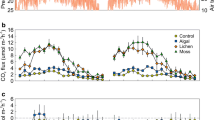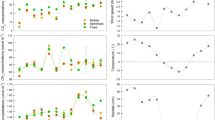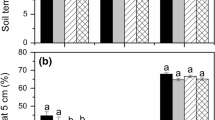Abstract
Deserts are sensitive to environmental changes caused by human interference and are prone to degradation. Revegetation can promote the reversal of desertification and the subsequent formation of fixed sand. However, the effects of grazing, which can cause the ground-surface conditions of fixed sand to further deteriorate and result in re-desertification, on the greenhouse gas (GHG) fluxes from soils remain unknown. Herein, we investigated GHG fluxes in the Hobq Desert, Inner Mongolia Autonomous Region of China, at the mobile (desertified), fixed (vegetated), and grazed (re-desertified) sites from January 2018 to December 2019. We analyzed the response mechanism of GHG fluxes to micrometeorological factors and the variation in global warming potential (GWP). CO2 was emitted at an average rate of 4.2, 3.7, and 1.1 mmol/(m2·h) and N2O was emitted at an average rate of 0.19, 0.15, and 0.09 μmol/(m2·h) at the grazed, fixed, and mobile sites, respectively. Mean CH4 consumption was as follows: fixed site (2.9 μmol/(m2·h))>grazed site (2.7 μmol/(m2·h))>mobile site (1.1 μmol/(m2·h)). GHG fluxes varied seasonally, and soil temperature (10 cm) and soil water content (30 cm) were the key micrometeorological factors affecting the fluxes. The changes in the plant and soil characteristics caused by grazing resulted in increased soil CO2 and N2O emissions and decreased CH4 absorption. Grazing also significantly increased the GWP of the soil (P<0.05). This study demonstrates that grazing on revegetated sandy soil can cause re-desertification and significantly increase soil carbon and nitrogen leakage. These findings could be used to formulate informed policies on the management and utilization of desert ecosystems.
Similar content being viewed by others
References
Brito L F, Azenha M V, Janusckiewicz E R, et al. 2015. Seasonal fluctuation of soil carbon dioxide emission in differently managed pastures. Agronomy Journal, 107(3): 957–962.
Búrquez A, Martínez-Yrízar A, Núñez S, et al. 2010. Aboveground biomass in three Sonoran Desert communities: Variability within and among sites using replicated plot harvesting. Journal of Arid Environments, 74(10): 1240–1247.
Cable J M, Ogle K, Lucas R W, et al. 2011. The temperature responses of soil respiration in deserts: a seven desert synthesis. Biogeochemistry, 103: 71–90.
Cao L H, Liu H M, Zhao S W, et al. 2012. Relationship between carbon and nitrogen in degraded alpine meadow soil. African Journal of Agricultural Research, 7(27): 3945–3951.
Castillo-Monroy A P, Maestre F T, Rey A, et al. 2011. Biological soil crust microsites are the main contributor to soil respiration in a semiarid ecosystem. Ecosystems, 14(5): 835–847.
Chimner R A, Cooper D J. 2003. Influence of water table levels on CO2 emissions in a Colorado subalpine fen: an in situ microcosm study. Soil Biology and Biochemistry, 35(3): 345–351.
de Klein C A M, Shepherd M A, van der Weerden T J. 2014. Nitrous oxide emissions from grazed grasslands: interactions between the N cycle and climate change—a New Zealand case study. Current Opinion in Environmental Sustainability, (9–10): 131–139.
de Vries F T, Williams A, Stringer F, et al. 2019. Changes in root-exudate-induced respiration reveal a novel mechanism through which drought affects ecosystem carbon cycling. The New Phytologist, 224(1): 132–145.
Douglas J T, Crawford C E. 1993. The response of a ryegrass sward to wheel traffic and applied nitrogen. Grass and Forage Science, 48(2): 91–100.
Dunmola A S, Tenuta M, Moulin A P, et al. 2010. Pattern of greenhouse gas emission from a Prairie Pothole agricultural landscape in Manitoba, Canada. Canadian Journal of Soil Science, 90(2): 243–256.
Elena V, Gulya K, Rauan Z, et al. 2020. Can conservation agriculture increase soil carbon sequestration? A modelling approach. Geoderma, 369: 114298, doi: https://doi.org/10.1016/j.geoderma.2020.114298.
Fitter A H, Self G K, Brown T K, et al. 1999. Root production and turnover in an upland grassland subjected to artificial soil warming respond to radiation flux and nutrients, not temperature. Oecologia, 120(4): 575–581.
Hammad H M, Nauman H M F, Abbas F, et al. 2020. Carbon sequestration potential and soil characteristics of various land use systems in arid region. Journal of Environmental Management, 264: 110254, doi: https://doi.org/10.1016/j.jenvman.2020.110254.
Hangs R D, Schoenau J J, Lafond G P. 2013. The effect of nitrogen fertilization and no-till duration on soil nitrogen supply power and post-spring thaw greenhouse-gas emissions. Journal of Plant Nutrition and Soil Science, 176(2): 227–237.
Howden S M, White D H, Mckeon G M, et al. 1994. Methods for exploring management options to reduce greenhouse gas emissions from tropical grazing systems. Climatic Change, 27(1): 49–70.
Hu C X, Liu Y D, Song L R, et al. 2002. Effect of desert soil algae on the stabilization of fine sands. Journal of Applied Phycology, 14(4): 281–292.
IPCC. 2014. Mitigation of Climate Change. Working Group III Contribution to the Fifth Assessment Report of the Intergovernmental Panel on Climate Change. In: Edenhofer O, Pichs-Madruga R, Sokona Y, et al. Cambridge and New York: Cambridge University Press.
Jones S K, Helfter C, Anderson M, et al. 2017. The nitrogen, carbon and greenhouse gas budget of a grazed, cut and fertilised temperate grassland. Biogeosciences, 14: 2069–2088.
Liu Q, Zhao C, Cheng X, et al. 2015. Soil respiration and carbon pools across a range of spruce stand ages, eastern Tibetan Plateau. Soil Science and Plant Nutrition, 61(3): 440–449.
Lohila A, Aurela M, Regina K, et al. 2003. Soil and total ecosystem respiration in agricultural fields: effect of soil and crop type. Plant and Soil, 251(2): 303–317.
Mark E R. 2020. Grazing management, forage production and soil carbon dynamics. Resources, 9(4): 49, doi: https://doi.org/10.3390/resources9040049.
Mosier A R, Delgado J A, Keller M. 1998. Methane and nitrous oxide fluxes in an acid Oxisol in western Puerto Rico: effects of tillage, liming and fertilization. Soil Biology and Biochemistry, 30(14): 2087–2098.
Papen H, Rennenberg H. 1990. Microbial processes involved in emissions of radiatively important trace gases. In: Transactions 14th International Congress Soil Science. Kyoto, 2: 232–237.
Poulter B, Frank D, Ciais P, et al. 2014. Contribution of semi-arid ecosystems to interannual variability of the global carbon cycle. Nature, 509: 600–603.
Priess J A, de Koning G H J, Veldkamp A. 2001. Assessment of interactions between land use change and carbon and nutrient fluxes in Ecuador. Agriculture, Ecosystems and Environment, 85(1–3): 269–279.
Qi Y S, Dong Y S, Zhang S. 2002. Methane fluxes of typical agricultural soil in the North China Plain. Journal of Ecology and Rural Environment, 18(3): 56–58, 60. (in Chinese)
Rustad L E, Huntington T G, Boone R D. 2000. Controls on soil respiration: Implications for climate change. Biogeochemistry, 48(1): 1–6.
Shi H Q, Hou L Y, Yang L Y, et al. 2017. Effects of grazing on CO2, CH4, and N2O fluxes in three temperate steppe ecosystems. Ecosphere, 8(4): e01760, doi: https://doi.org/10.1002/ecs2.1760.
Song C C, Zhang J B, Wang Y Y, et al. 2008. Emission of CO2, CH4 and N2O from freshwater marsh in northeast of China. Journal of Environmental Management, 88(3): 428–436.
Song W M, Chen S P, Wu B, et al. 2012. Vegetation cover and rain timing co-regulate the responses of soil CO2 efflux to rain increase in an arid desert ecosystem. Soil Biology and Biochemistry, 49: 114–123.
Soussana J F, Allard V, Pilegaard K, et al. 2007. Full accounting of the greenhouse gas (CO2, N2O, CH4) budget of nine European grassland sites. Agriculture Ecosystems and Environment, 121(1–2): 121–134.
Subke J A, Reichstein M, Tenhunen J D. 2003. Explaining temporal variation in soil CO2 efflux in a mature spruce forest in Southern Germany. Soil Biology and Biochemistry, 35(11): 1467–1483.
van den Pol-van Dasselaar A, Oenema O. 1999. Methane production and carbon mineralisation of size and density fractions of peat soils. Soil Biology and Biochemistry, 31(6): 877–886.
Wang B, Duan Y X, Wang W F, et al. 2020. Desertification reversion alters soil greenhouse gas emissions in the eastern Hobq Desert, China. Environmental Science and Pollution Research, 27(13): 15624–15634.
Wang B, Liu J, Zhang X, et al. 2021. Changes in soil carbon sequestration and emission in different succession stages of biological soil crusts in a sand-binding area. Carbon Balance and Management, 16(1): 27, doi: https://doi.org/10.1186/s13021-021-00190-7.
Wang Y S, Hu Y Q, Ji B M, et al. 2003. An investigation on the relationship between emission/ uptake of greenhouse gases and environmental factors in semiarid grassland. Advances in Atmospheric Sciences, 20(1): 295–310.
Wolf I, Russow R. 2000. Different pathways of formation of N2O, N, and NO in black earth soil. Soil Biology and Biochemistry, 32(2): 229–239.
Wu X, Yao Z S, Brüggemann N, et al. 2010. Effects of soil moisture and temperature on CO2 and CH4 soil-atmosphere exchange of various land use/cover types in a semi-arid grassland in Inner Mongolia, China. Soil Biology and Biochemistry, 42(5): 773–787.
Yu K W, Chen G X, Xu H. 2006. Rice yield reduction by chamber enclosure: a possible effect on enhancing methane production. Biology and Fertility of Soils, 43(2): 257–261.
Zhang Z S, Li X R, Nowak R S, et al. 2013. Effect of sand-stabilizing shrubs on soil respiration in a temperate desert. Plant and Soil, 367(1–2): 449–463.
Zhou P, Han G D, Wang C J, et al. 2011. Effects of stocking rates on carbon flux in the desert grassland ecological system of Inner Mongolia. Journal of Inner Mongolia Agricultural University (Natural Science Edition), 32(4): 59–64. (in Chinese)
Zhou Z C, Gan Z T, Shangguan Z P, et al. 2010. Effects of grazing on soil physical properties and soil erodibility in semiarid grassland of the Northern Loess Plateau (China). CATENA, 82(2): 87–91.
Acknowledgements
The study was supported by the Inner Mongolia Science and Technology Project of China (2022YFDZ0027) and the Mongolia Basic Geographical Factors and Land Use/Cover Survey of China (2017FY101301-4).
Author information
Authors and Affiliations
Corresponding author
Rights and permissions
About this article
Cite this article
Wang, B., Li, Y. & Bao, Y. Grazing alters sandy soil greenhouse gas emissions in a sand-binding area of the Hobq Desert, China. J. Arid Land 14, 576–588 (2022). https://doi.org/10.1007/s40333-022-0095-8
Received:
Revised:
Accepted:
Published:
Issue Date:
DOI: https://doi.org/10.1007/s40333-022-0095-8




